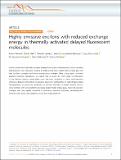Files in this item
Highly emissive excitons with reduced exchange energy in thermally activated delayed fluorescent molecules
Item metadata
| dc.contributor.author | Pershin, Anton | |
| dc.contributor.author | Hall, David | |
| dc.contributor.author | Lemaur, Vincent | |
| dc.contributor.author | Sancho-Garcia, Juan-Carlos | |
| dc.contributor.author | Muccioli, Luca | |
| dc.contributor.author | Zysman-Colman, Eli | |
| dc.contributor.author | Beljonne, David | |
| dc.contributor.author | Olivier, Yoann | |
| dc.date.accessioned | 2019-02-11T17:30:05Z | |
| dc.date.available | 2019-02-11T17:30:05Z | |
| dc.date.issued | 2019-02-05 | |
| dc.identifier | 257704053 | |
| dc.identifier | 90cd7844-8636-4379-9767-941d9fe3c11f | |
| dc.identifier | 85061138931 | |
| dc.identifier | 000457749000006 | |
| dc.identifier.citation | Pershin , A , Hall , D , Lemaur , V , Sancho-Garcia , J-C , Muccioli , L , Zysman-Colman , E , Beljonne , D & Olivier , Y 2019 , ' Highly emissive excitons with reduced exchange energy in thermally activated delayed fluorescent molecules ' , Nature Communications , vol. 10 , 597 . https://doi.org/10.1038/s41467-019-08495-5 | en |
| dc.identifier.issn | 2041-1723 | |
| dc.identifier.other | RIS: urn:C35ED44EDD9F65A297913F28254DE844 | |
| dc.identifier.other | RIS: Pershin2019 | |
| dc.identifier.other | ORCID: /0000-0001-7183-6022/work/56639118 | |
| dc.identifier.uri | https://hdl.handle.net/10023/17040 | |
| dc.description | The work was supported by the European Union’s Horizon 2020 research and innovation program under Grant Agreement N°. 646176 (EXTMOS project). A.P. acknowledges the financial support from the Marie Curie Fellowship (MILORD project, N°. 748042). Computational resources have been provided by the Consortium des Équipements de Calcul Intensif (CÉCI), funded by the Fonds de la Recherche Scientifiques de Belgique (F.R.S.-FNRS) under Grant No. 2.5020.11, as well as the Tier-1 supercomputer of the Fédération Wallonie-Bruxelles, infrastructure funded by the Walloon Region under the grant agreement n1117545. The St Andrews team would like to thank the Leverhulme Trust (RPG-2016-047) and EPSRC (EP/P010482/1) for financial support. | en |
| dc.description.abstract | Unlike conventional thermally activated delayed fluorescence chromophores, boron-centered azatriangulene-like molecules combine a small excited-state singlet-triplet energy gap with high oscillator strengths and minor reorganization energies. Here, using highly correlated quantum-chemical calculations, we report this is driven by short-range reorganization of the electron density taking place upon electronic excitation of these multi-resonant structures. Based on this finding, we design a series of π-extended boron- and nitrogen-doped nanographenes as promising candidates for efficient thermally activated delayed fluorescence emitters with concomitantly decreased singlet-triplet energy gaps, improved oscillator strengths and core rigidity compared to previously reported structures, permitting both emission color purity and tunability across the visible spectrum. | |
| dc.format.extent | 5 | |
| dc.format.extent | 833983 | |
| dc.language.iso | eng | |
| dc.relation.ispartof | Nature Communications | en |
| dc.subject | QD Chemistry | en |
| dc.subject | NDAS | en |
| dc.subject | BDC | en |
| dc.subject.lcc | QD | en |
| dc.title | Highly emissive excitons with reduced exchange energy in thermally activated delayed fluorescent molecules | en |
| dc.type | Journal article | en |
| dc.contributor.sponsor | EPSRC | en |
| dc.contributor.sponsor | The Leverhulme Trust | en |
| dc.contributor.institution | University of St Andrews. School of Chemistry | en |
| dc.contributor.institution | University of St Andrews. EaSTCHEM | en |
| dc.identifier.doi | 10.1038/s41467-019-08495-5 | |
| dc.description.status | Peer reviewed | en |
| dc.identifier.grantnumber | EP/P010482/1 | en |
| dc.identifier.grantnumber | RPG-2016-047 | en |
This item appears in the following Collection(s)
Items in the St Andrews Research Repository are protected by copyright, with all rights reserved, unless otherwise indicated.

